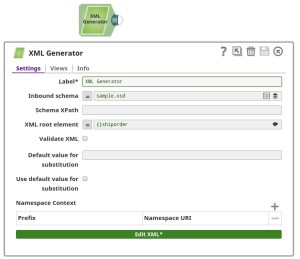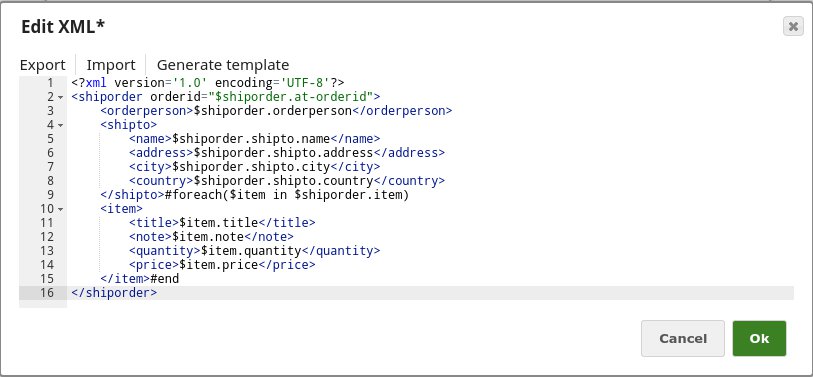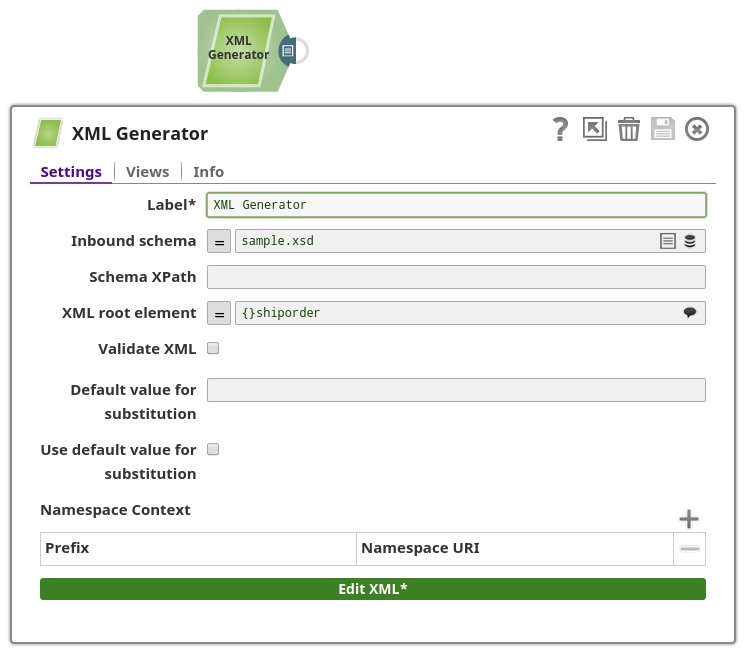The XML Generator Snap was introduced in the Summer 2014 release. In the Fall release, it was enhanced with the addition of XML generation based on a provided XSD and the suggestion of the JSON schema (based of the XSD schema) to the upstream Snap. The XML Generator Snap is similar to the XML Formatter Snap, which formats incoming documents into XML, however this Snap allows you to map to the XML content to allow a more specific XML generation. In a four-part series, we will explain how the XML Generator Snap:
- Allows you to generate the XML based off an XSD
- Allows you to map to the JSON schema upstream
- Validates the generated XML against the XSD
- Creates one serialized XML string for every input document
Example 1: XML Generation via XSD
For this first example, I created a simple pipeline to generate order data XML directly with the XML Generator Snap.
We provide the sample XSD (originating from: http://www.w3schools.com/schema/schema_example.asp) defined as:
<?xml version="1.0" encoding="UTF-8" ?>
<xs:schema xmlns:xs="http://www.w3.org/2001/XMLSchema">
<xs:element name="shiporder">
<xs:complexType>
<xs:sequence>
<xs:element name="orderperson" type="xs:string"/>
<xs:element name="shipto">
<xs:complexType>
<xs:sequence>
<xs:element name="name" type="xs:string"/>
<xs:element name="address" type="xs:string"/>
<xs:element name="city" type="xs:string"/>
<xs:element name="country" type="xs:string"/>
</xs:sequence>
</xs:complexType>
</xs:element>
<xs:element name="item" maxOccurs="unbounded">
<xs:complexType>
<xs:sequence>
<xs:element name="title" type="xs:string"/>
<xs:element name="note" type="xs:string" minOccurs="0"/>
<xs:element name="quantity" type="xs:positiveInteger"/>
<xs:element name="price" type="xs:decimal"/>
</xs:sequence>
</xs:complexType>
</xs:element>
</xs:sequence>
<xs:attribute name="orderid" type="xs:string" use="required"/>
</xs:complexType>
</xs:element>
</xs:schema>
We then suggest the XML root element, which returns {}shiporder.
Finally, we click on Edit XML which will automatically trigger the XML template generation based off the XSD, as seen below.
Now we could replace the variables with our own values to generate the XML on the output view or move on to the next example.
Note: The execution of the Snap above will create an XML attribute on the output view which provides the serialized XML content as a string.
In part two of this series, you will see how to use a JSON Generator to map to the XML Generator XSD.
Other Resources:
- Cloud Integration: There’s a Snap for That!
- SnapLogic Developer Community (login required)











